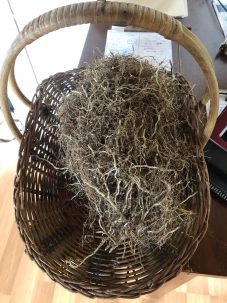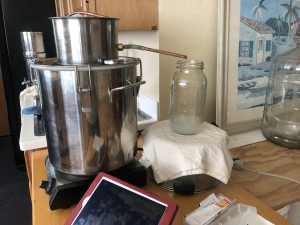
Instructions
Vetiver Hydrosol – Vetiveria zizanioides
Distilling vetiver is no easy task, the medicine is in it’s mighty roots which run far and deep and require lots of work to prepare for distillation. I have to give the credit for that work to my neighbor Barbara. She grows vetiver on her farm and took the time to dig up the roots and clean them, and then shared with me <3 I then chopped and distilled them, they are so tenacious even chopping them was no easy task.
Because we use the roots, vetiver is very grounding and calming. Helps to focus our scattered thoughts, slow us down and give us a moment to stake our direction. Vetiver makes one feel rooted, bringing us back to Mother Earth, keeping our feet on solid ground.
Roots are also very cooling and vetiver can be cooling to you on a hot day, and cooling to a hot flash.
The aroma is a bit more musty than the essential oil; this hydrosol has a hint of the same scent you will get in the essential oil but with a more musty aroma.
2 oz bottle with spray top $12.00
4 oz bottle with screw top $22.00
Contact Bobbi to order.
Vetiver Benefits:
THERAPEUTIC ACTIONS:
Anti-inflammatory, antirheumatic, antiseptic, antispasmodic, aphrodisiac, astringent, circulatory tonic (arterial and venous), immune modulatory, nervine, sedative
KEYWORDS: calming, grounding, balancing
Due to vetiver improving circulation my favorite way to use it is to spray it on my legs and body just prior to moisturizing. I also like to spray vetiver around me where I sit for meditation.
About Hydrosols: They are under appreciated currently! They have so much to offer.
The word “hydrosol” is derived from the Greek hydro, meaning water, and the Latin sol, meaning solution. When plants are distilled, an essential oil and a hydrosol are produced.
Hydrosols, are the water product of distillation. They carry the hydrophilic (water-soluble) components of the plant, as well as microscopic droplets of essential oils in suspension. Hydrosols have 1% or less of essential oils in them.
- Are best used to help add moisture to your skin care routine by spritzing on your face and body prior to moisturizing.
- Are anti-inflammatory and also cooling, useful with aloe vera gel to cool pitta /inflamed conditions e.g. too much heat in the body causing outward representation on the skin.
- Are effective wound healing agents.
- Can be used as effective toners.
- Are safe for internal use (try a teaspoon in a glass of water for a refreshing drink). If you are sensitive to acidic foods, citrus hydrosol are quite acidic and might not be your best option to enhance your water.
- Can be supportive to cooling or relaxing of the body/nervous system/mind (think aromatic spritzers). A true hydrosol is NOT water with essential oils in it, most spritzers are. The best spritzers are true hydrosols.
How to use hydrosols?
Most common:
#1 mist face and body prior to oil or moisturizer. This helps your oil to seal the moisture into your skin.
Water attracts water, when you just spray your face or even take a bath without moisturizing the water from the shower or spray will pull the water from your skin. However if you mist your face with water or hydrosol, then immediately apply moisturizer or oil the water in your skin will pull the water on the surface inward to deeper layers of your skin providing better moisture in your skin.
- Need to uplift your mood? Use grapefruit hydrosol.
- Want to brighten your skin or balance your hormones? Use rose geranium hydrosol.
- Working on a big project, school, or learning and remembering something? use rosemary hydrosol.
- Feeling a little congested? Try the red bottlebrush (eucalyptus) hydrosol.
- Have a little cut or scrape? Use yarrow hydrosol
Use as a toner, pour a little on an organic cotton pad or ball. Or blend 2 different hydrosols and add a little aloe vera or witch hazel hydrosol and make a toner. I offer these here.
In your hair! Mist your hair and fluff it with your fingers, hydrosols help to keep your hair clean and fresh. Rosemary is particularly good for your hair, helping it to grow in thicker. Rose Geranium or Grapefruit hydrosols are nice because they are a little astringent and will help to remove oil or dirt from your hair.
Add 1 tsp to a cup of water and enjoy.
Air spritzer – works great in the bathroom
I gargle with hydrosols! My favorite to gargle with is rose geranium.
Eye Pads – soak a cotton pad in hydrosol and lay one on each eye — this is nice when the hydrosol is chilled.
Feeling a little hot flash? Spritz your face with a hydrosol.
Medicinal:
Eye infections, of any type that I’ve experienced have been nipped in the bud many times by me spraying one of my hydrosols on at the first sign of any symptoms.
Poison Ivy – I have found hydrosol helpful at receiving itch from poison ivy — specifically rose, chamomile, and peppermint, used singly.
Spray on a cut or wound to aid in healing and cleaning. Yarrow is especially good at this, it is a wound healer.
Compresses – after you heat the water and wet your cloth, wring it out, then add a few spritzes of hydrosol.
Other:
Use in your clay mask recipe – after applying mask spritz your face with a hydrosol to keep your mask from drying out too quickly. (I use hydrosols in all the lotions make.)
Add up to 1 tsp to your neti pot water
Use 1 cup in a foot bath or hand bath
Add 1-2 cups to your bath (not very practical for most, but if you happen to have an abundance of a certain hydrosol).
In the laundry you can dampen a washcloth with hydrosol and put in dryer to help freshen stale or stinky clothing.
In the Kitchen
Freeze it in ice cube trays and use in iced tea.
You can even cook with them, they can add nice flavor when some of the water for rice is substituted with hydrosol.
Try soaking nuts in a tasty hydrosol like rose geranium or orange.

